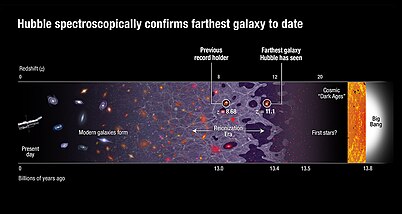GN-z11 is a high-redshift galaxy found in the constellation Ursa Major. It is among the farthest known galaxies from Earth ever discovered.[5][6] The 2015 discovery was published in a 2016 paper headed by Pascal Oesch and Gabriel Brammer (Cosmic Dawn Center). Up until the discovery of JADES-GS-z13-0 in 2022 by the James Webb Space Telescope, GN-z11 was the oldest and most distant known galaxy yet identified in the observable universe,[7] having a spectroscopic redshift of z = 10.957, which corresponds to a proper distance of approximately 32 billion light-years (9.8 billion parsecs).[8][note 1] Data published in 2024 established that the galaxy contains the most distant, and therefore earliest, black hole known in the universe,[9][10] estimated at around 1.6 million solar masses.[11]
| GN-z11 | |
|---|---|
 GN-z11 superimposed on an image from the GOODS-North survey | |
| Observation data (J2000[1] epoch) | |
| Constellation | Ursa Major[1] |
| Right ascension | 12h 36m 25.46s[1] |
| Declination | +62° 14′ 31.4″[1] |
| Redshift | 10.6034±0.0013[2] |
| Heliocentric radial velocity | 295,050 ± 119,917 km/s (183,336 ± 74,513 mi/s)[3] |
| Distance |
|
| Apparent magnitude (V) | 25.8H |
| Characteristics | |
| Type | Irregular |
| Mass | ~1×109[4] M☉ |
| Size | 4,000 ± 2,000 ly (1,200 ± 610 pc)[4] |
| Apparent size (V) | 0.6arcsec[4] |
| Other designations | |
| GN-z10-1,[4] GNS-JD2[3] | |
The object's name is derived from its location in the GOODS-North field of galaxies and its high cosmological redshift number (GN + z11).[12] It is observed as it existed 13.4 billion years ago, just 400 million years after the Big Bang;[4][13][14] as a result, its distance is sometimes inappropriately[15] reported as 13.4 billion light-years, its light-travel distance measurement.[16][17]
In early 2023, James Webb Space Telescope observed the galaxy and reported a definitive redshift of Z=10.6034 ± 0.0013.[2]
The galaxy has such a high redshift that its angular diameter distance is actually less than that of some galaxies with lower redshift. This means that the ratio of its angular size to its size in light-years is greater.[clarification needed]
Discovery
The galaxy was identified by a team studying data from the Hubble Space Telescope's Cosmic Assembly Near-infrared Deep Extragalactic Legacy Survey (CANDELS) and Spitzer Space Telescope's Great Observatories Origins Deep Survey-North (GOODS-North).[18][19] The research team used Hubble's Wide Field Camera 3 to measure the distance to GN-z11 spectroscopically, measuring the redshift caused by the expansion of the universe.[20] The findings, which were announced in March 2016, revealed the galaxy to be farther away than originally thought, at the distance limit of what the Hubble Telescope can observe. GN-z11 is around 150 million years older than the previous record-holder EGSY8p7,[12] and is observed (shortly after but) "very close to the end of the so-called Dark Ages of the universe",[20] and (during but) "near the very beginning" of the reionization era.[18]
Compared with the Milky Way galaxy, GN-z11 is 1⁄25 of the size, has 1% of the mass, and is forming new stars approximately twenty times as fast.[20] With a stellar age estimated at 40 million years, it appears the galaxy formed its stars relatively rapidly.[4] The fact that a galaxy so massive existed so soon after the first stars started to form is a challenge to some current theoretical models of the formation of galaxies.[18][20]
See also
Notes
References

